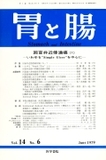Japanese
English
- 有料閲覧
- Abstract 文献概要
- 1ページ目 Look Inside
大腸癌は大腸の腺腫(Adenoma)から発生するという説が有力であるが,なおde novoの発生の可能性も論じられている.しかるに,腺腫癌化説(Adenoma-carcinoma sequence)の重要な根拠の1つとなっている,家族性大腸ポリポージスにおける無数の腺腫の存在とは異なり,われわれが日常取り扱う単発の大腸癌の背景大腸粘膜には,腺腫癌化説の基盤となるべき腺腫の併存頻度およびその数が,いかにも少なすぎると常々考えていた.もしほとんどすべての大腸癌が,腺腫を経由して発生するとするならば,家族性大腸ポリポージスにあらざる大腸癌や良性大腸疾患においても,もっとずっと多数の腺腫が発見されてしかるべきではなかろうか.そこで今回われわれは,単発性大腸進行癌・良性大腸疾患および家族性大腸ポリポージスの切除標本を用いて,それらの背景大腸粘膜の状態について調べることとした.
The fact that there are numerous adenomas in the colonic mucosa bearing familial colonic polyposis is one of the important base for the theory of adenoma-carcinoma sequence in the colon. On the other hand, it seems that there are comparatively too little incidence of coexisting adenomas of the colon bearing ordinary single carcinoma. The purpose of this paper is to report our histological study of the colonic mucosa as backgrounds of various diseases of the colon.
The material consisted of 17 cases of single advanced carcinoma (cancer group), 4 cases of benign lesions (benign group), and 4 cases of familial colonic polyposis (polyposis group). Fixed specimens of the colon in these 25 cases were stepsectioned perpendicularly to the long axis with each slice being about 7 mm.
(1) The changes of the basal cell layer: Glandular tubules at the basal cell layer, a proliferative zone, were found densely packed with rather a small number of goblet cells in the cancer group. On the contrary, clear and loose with completely differentiated goblet cells in the polyposis group. The findings in the benign group were similar to those in the cancer group.
(2) Buds of adenoma: Minute adenomas (bud of adenoma), which were macroscopically unrecognizable, were found by 16 lesions in 8 cases of the cancer group, 1 lesion in a case of the benign group and numerous in all cases of the polyposis group. All of them developed from the basal cell layer.
These findings indicate that the colonic mucosa of the cancer group and benign group is similar to each other, but is different from that of the polyposis group, and that adenomas particularly minute buds which have not been cited in the past are not uncommon in the non-polyposis groups.

Copyright © 1979, Igaku-Shoin Ltd. All rights reserved.


